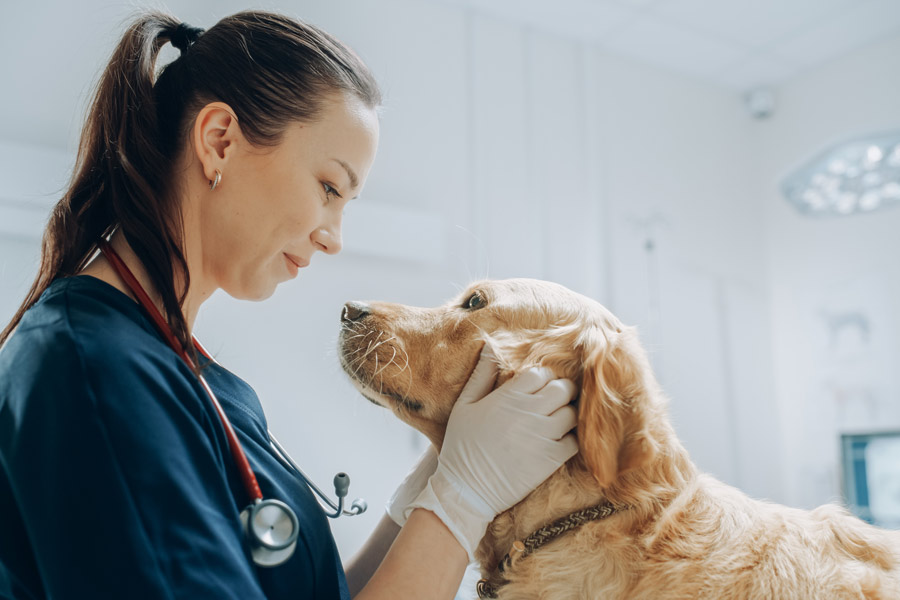
Our faithful four-legged friends, dogs, are prone to a variety of diseases that can significantly affect their quality of life. It is essential for every dog caregiver to know these diseases, their symptoms, to understand how to prevent or treat them.
In this article, we explore the most common diseases of dogs, from parasite infections to genetic conditions, and try to understand together the importance of a precautionary approach for the health of our fur baby.

Mutual support is fundamental in the relationship between human and dog.
Parasitic diseases in dogs
Parasites are among the main enemies of the well-being of our four-legged friends. These organisms are not directly responsible for diseases, but act as carriers of a virus. In other words, they carry the virus inside their body and then transmit it to other organisms.
Let’s see the most frequent and widespread dog diseases originated from parasites.
Leishmaniasis
It is a chronic, infectious and contagious disease that requires a biological carrier to be transmitted. Canine Leishmaniasis in Europe is caused by the Leishmania parasite, which is in turn transmitted by the bite of small insects, the Phlebotomus Papatasi, more commonly called Sandflies. It is a disease recognized as anthropozoonosis, which means that in some conditions it is also transmissible to humans.
This disease affects dogs which, bitten by the insect, can show very serious symptoms, individually or in groups. Sometimes it only entails skin symptoms, other times it can also affect internal organs causing various symptoms, some of the main ones are:
- alopecia (perdita di pelo) nella zona degli occhi, sulle zampe e sul dorso
- dermatiti secche
- lesioni alla pelle, con perdita di pelo visibile, ad esempio sulle orecchie e sul tartufo
- dolori articolari
- danni renali con anoressia, vomito, diarrea e criticità neurologiche
There are several types of vaccines indicated for asymptomatic and seronegative dogs, although preventive vaccination does not appear to provide complete protection.
It is recommended to start by carrying out the necessary visits and tests at a professional vet. Then, in case of confirmed diagnosis, or not, it is possible to undertake specific care for the treatment of this disease, through therapies which are continuously under studies and checks.
To protect our four-legged heart from Leishmaniasis, it is important to know the prophylaxis to be adopted. Nowadays there are several practical solutions to ward off these parasites, such as specific collars, handy pipettes to be applied monthly directly on the skin of our fur baby, as well as natural repellent products useful for enhancing the effect of the chosen anti-parasitic.
Filariasis
Filariasis is a chronic degenerative disease and it is good to remember that, in the most serious cases, if not diagnosed promptly, it could lead to death. It is a disease carried by mosquitoes and in particular, according to recent studies, the tiger mosquito is the main cause of the spread of this disease.
Depending on the carried parasite, Filariasis can have a cardiopulmonary or cutaneous form. It is essential to verify carefully that a person with filariasis is not also a carrier of leishmaniasis or other tick-borne diseases.
Here are some of the symptoms caused by this disease:
- itching
- presence of subcutaneous nodules
- decreased appetite
- tiredness and physical fatigue
- dry cough
- anemia
If untreated, unfortunately, it can worsen and lead to pulmonary embolism, heart failure, accumulation of fluids in the abdomen and neurological signs.
For this reason, it is recommended, as it happens with all diseases transmitted by insects and parasites, to proceed with the correct preventive prophylaxis.
Giardiasis
The Giardiasis takes its name from the protozoan responsible for the contamination, it is an infection of the gastrointestinal tract. The Giardiasis can be contracted in several ways: drinking from puddles of water, ingesting parts of the soil, from contaminated food or from the feces of an infected animal.
For a dog, the possibility of contracting this infection depends greatly on his state of health. In fact, a strong immune system can help the fur baby defend himself from the infectious action of Giardiasis, vice versa a young or elderly dog, or one with a not so great state of health, can get sick more easily.
Some of the symptoms of this very common infection are:
- sudden diarrhea
- soft, smelly greenish feces
- dehydration
- malabsorption of ingested foods
- abdominal pain
- loss of appetite
- vomiting, although not so common
The disease is diagnosed by the veterinarian through feces examination tests and, once the presence of the parasite is found, it is treated pharmacologically with specific medicines. It could last weeks, so if you have other four-legged friends at home, a temporary separation is advisable to avoid contagion.
Once your four-legged heart has recovered, remember to give him a bath after the last day of treatment, because cleaning his skin, coat and private parts is always very important for both him and those around him.

If your dog sleeps more than usual and doesn’t want to move, a visit to the vet is appropriate.
Ehrlichiosis
It is among the most common dog diseases transmitted by carriers, in this case by ticks that act as carriers of the Ehrlichia Canis parasite. This disease, with incubation between 8 and 20 days, can lead to fever, loss of appetite and anemia.
The bacterium infects the dog’s red blood cells and then reaches the organs and can have different forms, depending on the health of the dog and his immune system: acute form, subacute form and chronic form.
The most recognizable symptoms are:
- alteration of blood values
- lack of platelets, consumed by the bacterium
- fever
- swollen lymph nodes
- lethargy
- loss of appetite and anorexia
- oculo-conjunctival discharge
In more serious cases epistaxis (nosebleeds), petechiae (punctate hemorrhages) and ecchymoses (bruises) could occur.
Some symptoms, such as fever, can be mistaken with the development of a simple flu. For this reason, if we notice that our four-legged heart seems to have something wrong, we must take him to the vet for a visit.
Ehrlichiosis can appear even months after infection and, in the most serious cases, can lead to the death of the dog even within a few days of the onset of symptoms.
The therapy to be followed to destroy this disease is aimed precisely at eliminating the bacterium. An antibiotic treatment may be enough, although sometimes adding an approach with glucocorticoids is necessary, especially in chronic forms.
In chronic forms, unfortunately, recovery is not very easy.
Scabies
Scabies, also called seven-year itch, is one of the most widespread parasitic diseases in dogs. Highly contagious, it is transmitted to our furry friends by the bite of the mite, carrier of the Sarcoptes Scabiei virus. The mite is an arachnid capable of living in any season and in any environment, which is why this disease is very widespread not only among dogs but also among cats, rabbits, foxes and even humans.
Severe itching and dermatitis with crusted skin are the main symptoms which, if not treated adequately, can degenerate into pustules, papules and skin lesions. Itching often affects the dog strongly, so much so that it causes him to scratch himself continuously, producing skin lesions.
This inflammatory pathology occurs in different types, more or less serious with different symptoms, and, once diagnosed with specific veterinary tests, is treated with patience and precision. To treat it, cycles of antibiotic therapy are applied but it is advisable to try to avoid it by giving importance to prevention through the application of anti-parasitics, combined with a healthy and balanced diet to keep the immune defenses high with periodic vet checks.

When the annoying itching is excessive, the dog can even injure himself.
Dog allergies
As for us humans, allergies are a common pathology in dogs. The triggering factors can belong to different natures, for example environmental or dietary. Let’s see the most widespread allergies among our four-legged friends.
Skin allergies
Skin allergy – or Allergic Dermatitis – is an ailment that affects the skin. It is usually caused by a reaction of the dog’s immune system, in response to a substance considered dangerous to his health. Insect bites, such as mosquitoes and small spiders, are among the most common causes but allergies can also occur, for example, after taking medications.
Symptoms include itching, skin redness and hair loss, in the areas where the redness is more persistent.
Sometimes symptoms disappear all alone in a short time, in other cases, however, when the allergy is caused by medicines or a diet not appropriate to the well-being of our fur baby, it will be necessary to intervene with a vet advice for a change in treatment or dietary style.
Respiratory allergies
Would you have ever said that dust, pollen and particular scents can also be enemies of our trusty dogs?
Well yes, for them too, respiratory allergies lead to symptoms common to us such as coughing, sneezing and nasal congestion. Just like for us human beings, this type of allergy can be easily resolved with the administration of antihistamines and, specifically for dogs, anti-parasitics against the small insects that live in the dust.

Pollen can be an enemy for our four-legged friends as well.
Gastrointestinal allergies
Nutrition for a dog is a really important aspect.
An unsuitable diet for our fur baby can cause the onset of allergies and intolerances recognizable in some characteristic symptoms such as:
- itching
- dry skin
- excessive eye discharge
- ear infection
- deficiency in the intestinal, urinary, musculoskeletal systems
- general fatigue
For this reason, identifying the best diet for our dog is essential.
By consulting your trusted vet, or a vet doctor expert in nutrition, you will be able to quickly solve the eating disorders of your beloved life partner.
Genetic dog diseases
Dog’s heart, bones, muscles and nerves are also areas prone to specific diseases.
The causes can be hereditary, just like for us humans, but sometimes it can happen that they arise from complications of less serious pathologies which could degenerate with time.
Heart diseases
Among heart diseases in dogs, the most common ones are genetic. In fact, in some breeds, heart diseases are a recurring phenomenon. For example, cardiac problems are typical of breeds such as the Doberman, the Dachshund, the Great Dane or the Bulldog.
The main symptoms include cough, lack of appetite, breathing difficulty and sudden collapse and fainting.
Bone and muscle diseases
Diseases that affect the bones of our four-legged friends are very widespread, more than we might think.
Generally, as age advances, the dog’s skeleton – like that of all living beings – tends to weaken and wear out. In some cases, however, bone pathologies can also occur at a younger age and often the cause is hereditary.
Dogs such as the Labrador, the German Shepherd, the Saint Bernard or the Rottweiler are subject to Hip Dysplasia, a pathology that causes the wear out of the cartilage between the pelvis and the femur. This hereditary disease causes walking difficulties and is able to affect his quality of life and physical performances. This joint malformation occurs during growth and can affect all breeds, specifically medium, large and giant sizes. Generally, the most severe forms occur when puppies, while the less serious ones occur in adulthood or old age.
Still talking about bones, as time goes on, arthritis and arthrosis are also common pathologies. The causes are bone wear and tear over time and also joint inflammations, these conditions cause pain in movement and muscle stiffness, moreover they debilitate dog’s ability to move by himself.

Tiredness and difficulty in moving are typical symptoms of dog arthritis.
Nervous system diseases
One of the best-known pathologies in dogs caused by the nervous system is Epilepsy. The disease is recognized quite quickly as it leads our four-legged friend to be prone to sudden and random convulsions, of variable duration and intensity. If we happen to think that our dog has just had an epileptic attack, the first thing to do would certainly be to take him immediately to the vet for a check-up.
Among the dog breeds most prone to epilepsy, we find the Beagle, the Dachshund, the Golden Retriever and the Labrador.
Another nervous disease is the degenerative Myelopathy. Unfortunately, as suggested by its name, it is a pathology that tends to worsen with the course of time, as it affects the nerve endings, blocking communication between the bone marrow and the lower part of the dog’s body. In the worst-case scenario this disease can cause hind legs paralysis.
Pug, Boxer, Corgi, American Water Spaniel and Bernese Mountain Dog are the dog breeds in which this disease occurs most frequently.
Autoimmune diseases in dogs
Autoimmune diseases do not only affect humans, they can also be part of the life of our fur babies.
As it happens with us, this type of disease is not contagious, in fact it affects the immune system of the individual which, once attacked, will respond in an anomalous way towards the body by not recognizing some parts.
The most frequently diagnosed diseases in dogs and cats are Pemphigus foliaceus and Lupus erythematosus. These diseases can affect pets of all breeds, sexes and ages.
The most common symptoms of an autoimmune disease in dogs can be:
- hair loss
- redness
- pustules formation
- ulcers
- scabs
Recognizing a disease like Lupus is not easy. To diagnose it, a biopsy based on the research of the typical signs of autoimmune diseases is necessary. It consists of taking a small piece of skin (where the problem occurs) under local or general anesthesia. Then, an analysis of the piece under the microscope is required.
Once the diagnosis has been confirmed, our trusted vet will propose an adequate therapy of cortisone or immunosuppressants. Later, the disease can be kept under control with necessary periodic examinations and perseverance in therapy.
Occasionally, however, relapses may occur during the life of the fur babies because, as happens to us humans, autoimmune diseases have no cure but their progression can be monitored and their symptoms can be limited.
Cancer in dogs
Perhaps not everyone knows it, but this disease is unfortunately a very common cause of vet visits.
In fact, cancer is a relatively widespread disease even in our four-legged hearts and, as for us humans, the forms in which it occurs can be multiple as well as the treatment methods that can be adopted.
The distinction between benign and malignant tumors is also valid for vet medicine. The difference can only be established after careful and accurate analyses of the dog’s state of health.
Tumors can occur in a visible form, such as through formation of cell masses that are palpable to the touch, but also with more hidden symptoms. Among these, the dog’s difficulty in regenerating wounds, fever, vomiting, continuous thirst or bleeding are clear signs that there is something wrong with our fur baby.
So what to do if our dog is diagnosed with cancer? The best thing to do is trust your vet! In fact, each form of cancer requires different diagnoses, analyses, treatments and timing. The right assessment of what to do is up to the veterinarian who, with his expertise and experience, will definitely focus on the well-being of your pet.

The vet is a point of reference for your dog’s health.
The importance of prevention in dog diseases
Prevention plays a key role in dog health.
Regular vet visits, vaccinations, a balanced diet and adequate physical exercise can prevent and reduce the risk of incurring the above mentioned diseases. It is then essential to monitor and identify, every day, the signals that our dog sends us. An animal that doesn’t feel well cannot hide his symptoms, for this reason it is good to remember that any behavior different from the usual represents the right opportunity to take our dog for a vet visit.
So do not hesitate, it is important for your four-legged heart to be checked by a specialist if he doesn’t seem to be in good shape, prevention is the most important thing for your life together.

A healthy dog is a happy dog!
Taking care of your dog’s health means getting to know him, observing him every day to notice if he isn’t feeling well.
Only in this way can we understand his needs even if he cannot tell us. We can be ready to identify the best solution to protect his well-being and guarantee him a happy life with us.
Whatever his state of health, we need to remember that it is a honor to share our life with him and to stand by his side!







